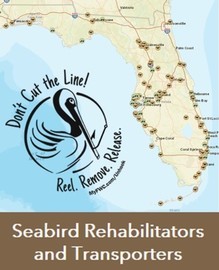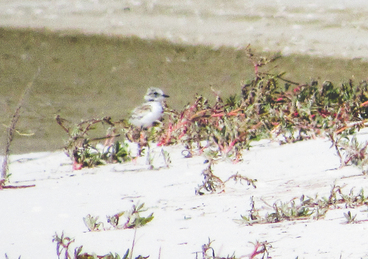Events
May 4: Save the birds this summer with each trip to the beach! Timucuan Shorebird Stewardship training from 10am-12pm (ET) at The Ribault Club, Jacksonville. RSVP to Chris Farrell @ cfarrell@audubon.org
May 12-13: World Migratory Bird Day
May 12: Pinellas County Mid-Season Stewardship Training for Black Skimmer Colonies with Audubon Florida. Starts at 8:00am (ET) at Tiki Gardens, Indian Shores. RSVP Holley Short @ hshort@audubon.org
May 15: Breakfast with the Birds - Connecting the Globe. Starts at 9:30am (ET) at Rookery Bay National Estuarine Research Reserve, Naples FL. Ticket info @ rookerybay.org or check it out on Facebook.
Reminders
May 13 - 19: is the next count window for the Breeding Bird Protocol. If you’re surveying a route with active nesting, weekly surveys help capture information about peak counts.
April 25 - June 20: To help with the 2018 rooftop study, please try to survey rooftop sites every week. To learn more about the study please read the article below.
May 26-29: Memorial Day Weekend! Shorebirds and seabirds nesting along the coast need more support during busy holiday weekends. Can you help? If so, contact a Stewardship Coordinator in your area.
 New
Seabird Rehabilitator and Transporter Locator App
The FWC’s Coastal Wildlife Conservation Initiative has just completed a new web application that allows people to locate rehabilitators and transporters for injured seabirds. It may be used by anglers who have hooked a bird with their fishing line or anyone who is seeking help for an injured seabird. All they need is a smartphone or tablet. Users can allow the app to access their location or pin a location on the map and select the radius (0-50 miles) they would like to search within.
This app is part of the FWC’s “Don’t Cut the Line” campaign. It was developed based on a need to quickly locate help for injured seabirds. Many of the providers on the FWC’s main rehabilitator list do not accept seabirds (they may provide care for mammals or other species), but all the providers in this app have been confirmed to accept seabirds. This means the user can make one phone call (with one click) instead of calling several until they find one who can help. The app will be updated on a regular basis to include new seabird rehabilitators and transporters and delete ones who are no longer providing service. For information about the required licenses for the providers, click on the “i” in the upper right corner of the app.
As FWC partners, please spread the word about the new app, which can be accessed on our webpage. The URL for the app is https://ocean.floridamarine.org/SeabirdRehabilitators. If you have any questions about this app, you may contact the CWCI coordinator, Fara Ilami, at fara.ilami@myfwc.com.
|

New Features on the Florida Shorebird Database
The FSD has a new way to search for users! When you log in, you will be asked who you would like to enter data for. If you are entering your own data, click the "Set for Myself" button. If you are entering data that someone else collected, click "Select Another User". You can search for other users by following the instructions that appear.
The new system for searching other users has improved the speed and performance of the FSD. It was developed because users (like you!) reported problems with the FSD. If you experience any issues with the performance of the website, please email FLShorebirdDatabase@myFWC.com. Your feedback is invaluable!
The 2018 webinars are online! After a delay due to technical difficulties, the instructional webinars are now live on the Resources tab of the FSD. If you have any questions, just email FLShorebirdDatabase@myFWC.com.
Team Effort
Helps Snowy Plover have Early Success at St. Joseph Peninsula State Park

When the first snowy plover nest at St. Joseph Peninsula State
Park for 2018 was found by a FWRI biologist, there was little hope of it
hatching. Although the nest was in the park’s Wilderness Preserve, it was at
the edge of the posted area along the bay shoreline and was exposed to
recreational disturbances. The posting was adjusted lower on the beach around
the nest, but this still provided only a 30-foot buffer from disturbance. Typically, adults can flush and stay away
from the nest when disturbances are closer than 300-feet.
When discovered, the nest had only one egg associated with a
territorial pair, better known by their unique color bands as Blue:Service//Yellow
Orange female and Service//White :
Red Red male. On the second nest visit, there was a second egg present and
the banded female was observed incubating the nest. Now at a full clutch of two
eggs, this nest would face many close-calls during the month-long incubation
period and again before the chick fledges. A week before hatching, the snowy
plover nest survived a severe storm, but lost one egg that was likely blown out
of the nest bowl by strong winds. On other visits, various predator tracks were
observed nearby the nest including opossums, bobcats, ghost crabs, and dogs.
To help alleviate recreational disturbance pressures FWRI
biologists collaborated with Audubon Florida due to the vulnerability of this
specific nest along with other nests at the north end of the peninsula. From this
collaborative effort, this nest survived Spring Break and successfully hatched
on Easter weekend. The chick that hatched from this nest was most recently observed
at 26 days old and is on track to fledge by early May!
|
 Photo provided by Audubon
Gravel rooftops in Florida are a key alternative nesting
habitat for threatened beach nesting birds such as the Least Tern, Black
Skimmer, Roseate Tern, and American Oystercathcer. The conservation value of
rooftops is of such importance that the future population trend of these
species is expected to be largely influenced by the availability of suitable
gravel rooftops and by the productivity of rooftop colonies. There is a need to
re-evaluate the current number of shorebirds and seabirds nesting on rooftops
and we need your help to successfully achieve this goal.
Partners and volunteers have played an enormous role on most of the current monitoring and management efforts to make a difference for shorebirds and seabirds nesting on Florida’s rooftops. For example, the data gathered by you helped us to identify the peak nesting season for Least Tern's using rooftops as nesting habitat (Figure 1). Our current efforts to re-evaluate the breeding population status of rooftop nesting birds would not be successful without the help from dedicated volunteers like you.
Figure 1: Peak Rooftop Nesting Times
|